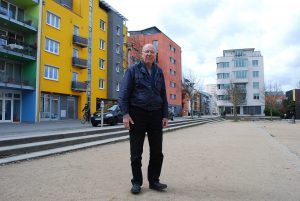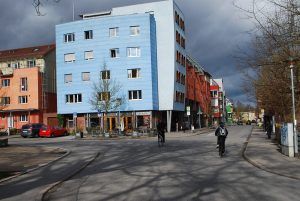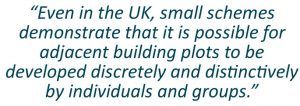Through entries to our annual SURF Awards for Best Practice, we have seen regeneration projects which have transformed communities, both socially and economically, through enhancements made to local buildings, streets and spaces. In this article, Dr Iqbal Hamiduddin of University College London demonstrates how well-designed housing and places can be brought about through a community-led approach, drawing on a self-build case study in Germany.
Why is it that we are drawn naturally to historic urban environments? Certainly we value the scarcity and interest of architecture of bygone times, but we also seem to enjoy the complexity of urbanism created in a building-by-building fashion. This sensual exuberance, diversity and playfulness is a quality that environmental psychologists call ‘fascination’. Historic quarters are, of course, collective products of individual craftsmanship that precede the planning controls, land speculation and the emergence of modern industrialised practices that favour simplicity.
But is it possible to create such mosaic style urbanism today? Community-led housing schemes could help make this a reality, as shown through Dutch schemes, including Nieuw Leiden and Almere, and in Germany, at sites across Freiburg and Berlin. Even in the UK, small schemes at Ashley Vale in Bristol or in more rural settings, such as Findhorn, demonstrate that it is possible for adjacent building plots to be developed discretely and distinctively by individuals and groups. In each of these cases, homes have been individually commissioned and resident groups have a strong input in the design and upkeep of their neighbourhood.
Self-Build Initiatives in Tübingen
In the German city of Tübingen, the Loretto Platz and French Quarter areas provide perhaps some of the finest examples of this community-led development model, supplying 1400 homes to the city’s southern fringe. Like Freiburg’s Vauban scheme, the two Tübingen sites were military bases for French garrisons that vacated soon after the fall of the Berlin Wall. The schemes, which form focal points within a wider urban extension, were the brainchild of Andreas Feldtkeller who sought to use a distributed process of building construction to develop distinctive place character.

Andreas Feldtkeller, chief planner for the Südstadt redevelopment, at Loretto Platz.
Group self-build was established as the approach used to construct approximately 90% of the homes and retrofit existing garrison blocks across the two sites. In this small, expensive university city, this self-build approach allowed households to enter home ownership who would otherwise have been priced out of the mainstream housing market. It also allowed the city to make stipulations for each building to contain non-residential uses on the street-facing ground floor areas. Drastic car-reduction measures could also be implemented across each of the two schemes that would have been unappealing to larger developers. Moreover, group self-build also allowed residential buildings of an urban scale and density to be produced – five or six storey buildings containing between five and up to a dozen or more apartments.
The Self-Build Process

Workshops and small manufacturing units in the French Quarter
To enter this process, prospective residents created or joined Baugruppen – building groups – to bid competitively for a development plot. They required an outline design to be prepared by an architect, as well as a private or public sector partner to use the non-residential space of the building. Groups were given largely free reign over the internal layout and external appearance of their building. Individually, some buildings appear unremarkable but the overall sense is one with far greater visual interest than is usual in new residential developments.
These areas are also characterised by high levels of non-residential land uses – small craft workshops and manufacturers in particular – integrated tightly among and within residential areas. My own research[1] indicates that over one third of employees also live within these neighbourhoods and the vast majority therefore walk or cycle to work, with consequent environment and health benefits. Socially, the concentration of employment allows those who need to work close to home and close to schools or care facilities an opportunity to enter the workplace. Economically, high levels of daytime activity also help to sustain a secondary diversity of retail, cafés and community amenities that would otherwise struggle to exist.

Tübingen’s French Quarter
Loretto and the French Quarter embody the ‘city of short distances’ model where essential aspects of daily life are geographically compressed – by intelligent land use planning as well as by pure building density. This has permitted a heavily car-reduced neighbourhood design with residential parking provided at the edge of each development as it is at Vauban.
Successes and Challenges
Is there a downside? Research I have undertaken with my colleague Nick Gallent[2] suggests that the Baugruppen model certainly has its weaknesses. Firstly, it is essentially a home ownership model that excludes those without access to the finance required. The model can therefore be rather exclusive, creating highly self-selective communities. It also requires a supporting ecosystem of industry specialists and financing organisations willing to lend to each individual household on a multi-apartment self-build.
Secondly, the Baugruppen model is both a descendant of Germany’s long-established mutual model of housing construction, and is strongly influenced by a housing market in which apartment renting prevails, and where the self and custom build sectors account for the majority of new homes built. Landowners therefore tend to be more sympathetic towards selling individual plots rather than a wholesale site. They also recognise the financial gains from this approach – the sum of individual sales usually being greater than a single transaction for an entire site.
The group self-build model may therefore be regarded as a product of its context. But this does not mean that it would be impossible in the UK, particularly in Scotland with its historically stronger culture of self-build and mutual outlook. Crisis has often been a driver of change and innovation, and Britain’s on-going housing crisis has caused both younger and older adults to turn to alternative solutions.

Community-led housing schemes – in their different forms – have a track record of delivering both long-term social and financial benefits, even if the development approach isn’t always easy in the short term. In fact, the development process itself can catalyse strong social relations within groups and between them. Importantly, it can also provide the means for producing vibrant, sustainable and socially amenable urban quarters for communities as Tübingen has demonstrated.
—-
[1] Hamiduddin, I. (2017) Journey to work travel outcomes from ‘city of short distances’ compact city planning in Tübingen, Germany. Planning Practice and Research – forthcoming.
[2] See Hamiduddin, I. and Gallent, N. (2015) Self-build communities: the rationale and experiences of group-build (Baugruppen) housing development in Germany. Housing Studies, 31(4) 365-383.

